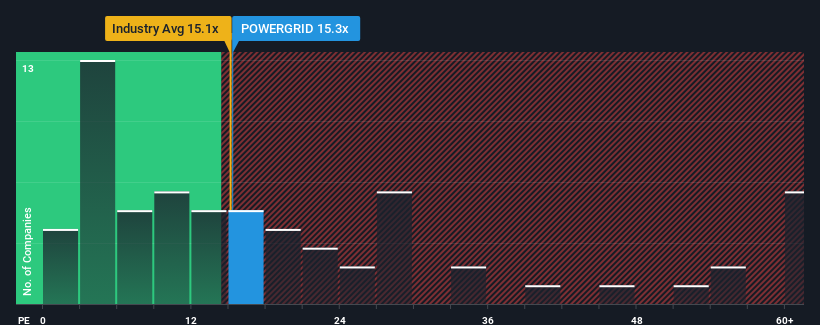- India
- /
- Electric Utilities
- /
- NSEI:POWERGRID
Why Investors Shouldn't Be Surprised By Power Grid Corporation of India Limited's (NSE:POWERGRID) Low P/E
With a price-to-earnings (or "P/E") ratio of 15.3x Power Grid Corporation of India Limited (NSE:POWERGRID) may be sending bullish signals at the moment, given that almost half of all companies in India have P/E ratios greater than 27x and even P/E's higher than 50x are not unusual. However, the P/E might be low for a reason and it requires further investigation to determine if it's justified.
While the market has experienced earnings growth lately, Power Grid Corporation of India's earnings have gone into reverse gear, which is not great. The P/E is probably low because investors think this poor earnings performance isn't going to get any better. If you still like the company, you'd be hoping this isn't the case so that you could potentially pick up some stock while it's out of favour.
View our latest analysis for Power Grid Corporation of India

How Is Power Grid Corporation of India's Growth Trending?
The only time you'd be truly comfortable seeing a P/E as low as Power Grid Corporation of India's is when the company's growth is on track to lag the market.
Retrospectively, the last year delivered a frustrating 1.1% decrease to the company's bottom line. This means it has also seen a slide in earnings over the longer-term as EPS is down 4.0% in total over the last three years. So unfortunately, we have to acknowledge that the company has not done a great job of growing earnings over that time.
Shifting to the future, estimates from the twelve analysts covering the company suggest earnings should grow by 4.3% over the next year. With the market predicted to deliver 25% growth , the company is positioned for a weaker earnings result.
In light of this, it's understandable that Power Grid Corporation of India's P/E sits below the majority of other companies. Apparently many shareholders weren't comfortable holding on while the company is potentially eyeing a less prosperous future.
The Final Word
It's argued the price-to-earnings ratio is an inferior measure of value within certain industries, but it can be a powerful business sentiment indicator.
We've established that Power Grid Corporation of India maintains its low P/E on the weakness of its forecast growth being lower than the wider market, as expected. At this stage investors feel the potential for an improvement in earnings isn't great enough to justify a higher P/E ratio. It's hard to see the share price rising strongly in the near future under these circumstances.
It is also worth noting that we have found 2 warning signs for Power Grid Corporation of India that you need to take into consideration.
If P/E ratios interest you, you may wish to see this free collection of other companies with strong earnings growth and low P/E ratios.
New: Manage All Your Stock Portfolios in One Place
We've created the ultimate portfolio companion for stock investors, and it's free.
• Connect an unlimited number of Portfolios and see your total in one currency
• Be alerted to new Warning Signs or Risks via email or mobile
• Track the Fair Value of your stocks
Have feedback on this article? Concerned about the content? Get in touch with us directly. Alternatively, email editorial-team (at) simplywallst.com.
This article by Simply Wall St is general in nature. We provide commentary based on historical data and analyst forecasts only using an unbiased methodology and our articles are not intended to be financial advice. It does not constitute a recommendation to buy or sell any stock, and does not take account of your objectives, or your financial situation. We aim to bring you long-term focused analysis driven by fundamental data. Note that our analysis may not factor in the latest price-sensitive company announcements or qualitative material. Simply Wall St has no position in any stocks mentioned.
About NSEI:POWERGRID
Power Grid Corporation of India
An electric power transmission utility, engages in the power transmission business in India and internationally.
Average dividend payer and fair value.
Market Insights
Community Narratives


Recently Updated Narratives


MINISO's fair value is projected at 26.69 with an anticipated PE ratio shift of 20x


Fiverr International will transform the freelance industry with AI-powered growth

Constellation Energy Dividends and Growth
Popular Narratives


MicroVision will explode future revenue by 380.37% with a vision towards success


NVDA: Expanding AI Demand Will Drive Major Data Center Investments Through 2026



